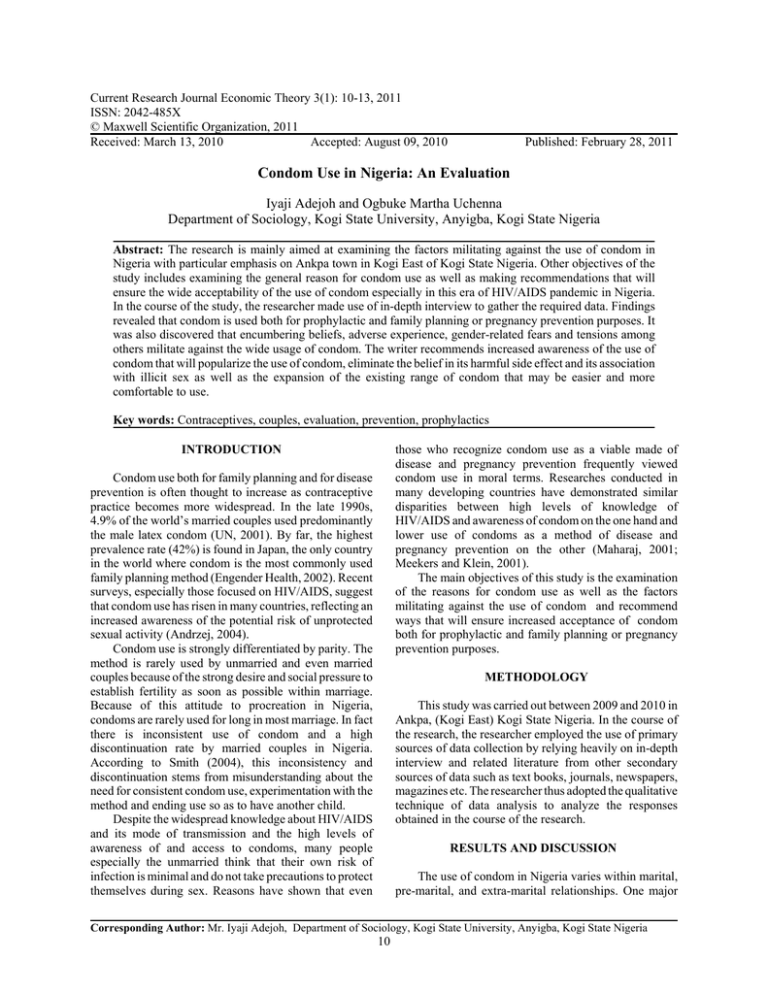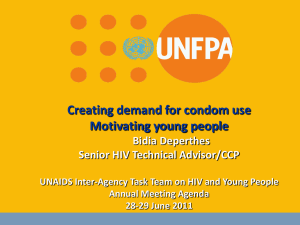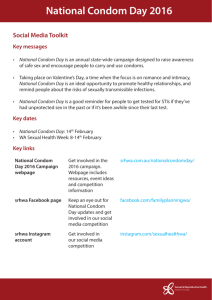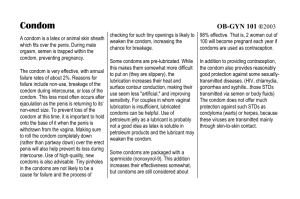
Current Research Journal Economic Theory 3(1): 10-13, 2011
ISSN: 2042-485X
© Maxwell Scientific Organization, 2011
Received: March 13, 2010
Accepted: August 09, 2010
Published: February 28, 2011
Condom Use in Nigeria: An Evaluation
Iyaji Adejoh and Ogbuke Martha Uchenna
Department of Sociology, Kogi State University, Anyigba, Kogi State Nigeria
Abstract: The research is mainly aimed at examining the factors militating against the use of condom in
Nigeria with particular emphasis on Ankpa town in Kogi East of Kogi State Nigeria. Other objectives of the
study includes examining the general reason for condom use as well as making recommendations that will
ensure the wide acceptability of the use of condom especially in this era of HIV/AIDS pandemic in Nigeria.
In the course of the study, the researcher made use of in-depth interview to gather the required data. Findings
revealed that condom is used both for prophylactic and family planning or pregnancy prevention purposes. It
was also discovered that encumbering beliefs, adverse experience, gender-related fears and tensions among
others militate against the wide usage of condom. The writer recommends increased awareness of the use of
condom that will popularize the use of condom, eliminate the belief in its harmful side effect and its association
with illicit sex as well as the expansion of the existing range of condom that may be easier and more
comfortable to use.
Key words: Contraceptives, couples, evaluation, prevention, prophylactics
INTRODUCTION
those who recognize condom use as a viable made of
disease and pregnancy prevention frequently viewed
condom use in moral terms. Researches conducted in
many developing countries have demonstrated similar
disparities between high levels of knowledge of
HIV/AIDS and awareness of condom on the one hand and
lower use of condoms as a method of disease and
pregnancy prevention on the other (Maharaj, 2001;
Meekers and Klein, 2001).
The main objectives of this study is the examination
of the reasons for condom use as well as the factors
militating against the use of condom and recommend
ways that will ensure increased acceptance of condom
both for prophylactic and family planning or pregnancy
prevention purposes.
Condom use both for family planning and for disease
prevention is often thought to increase as contraceptive
practice becomes more widespread. In the late 1990s,
4.9% of the world’s married couples used predominantly
the male latex condom (UN, 2001). By far, the highest
prevalence rate (42%) is found in Japan, the only country
in the world where condom is the most commonly used
family planning method (Engender Health, 2002). Recent
surveys, especially those focused on HIV/AIDS, suggest
that condom use has risen in many countries, reflecting an
increased awareness of the potential risk of unprotected
sexual activity (Andrzej, 2004).
Condom use is strongly differentiated by parity. The
method is rarely used by unmarried and even married
couples because of the strong desire and social pressure to
establish fertility as soon as possible within marriage.
Because of this attitude to procreation in Nigeria,
condoms are rarely used for long in most marriage. In fact
there is inconsistent use of condom and a high
discontinuation rate by married couples in Nigeria.
According to Smith (2004), this inconsistency and
discontinuation stems from misunderstanding about the
need for consistent condom use, experimentation with the
method and ending use so as to have another child.
Despite the widespread knowledge about HIV/AIDS
and its mode of transmission and the high levels of
awareness of and access to condoms, many people
especially the unmarried think that their own risk of
infection is minimal and do not take precautions to protect
themselves during sex. Reasons have shown that even
METHODOLOGY
This study was carried out between 2009 and 2010 in
Ankpa, (Kogi East) Kogi State Nigeria. In the course of
the research, the researcher employed the use of primary
sources of data collection by relying heavily on in-depth
interview and related literature from other secondary
sources of data such as text books, journals, newspapers,
magazines etc. The researcher thus adopted the qualitative
technique of data analysis to analyze the responses
obtained in the course of the research.
RESULTS AND DISCUSSION
The use of condom in Nigeria varies within marital,
pre-marital, and extra-marital relationships. One major
Corresponding Author: Mr. Iyaji Adejoh, Department of Sociology, Kogi State University, Anyigba, Kogi State Nigeria
10
Curr. Res. J. Econ. Theory, 3(1): 10-13, 2011
the widespread belief amongst married couples that
condoms are fragile and ineffective as contraceptives and
therefore, risky. Most men, in particular have the
conviction that condoms break often and offer little
protection against unwanted pregnancy and the risk of
STIs. This concern with the functional or mechanical
aspects of condom performance is often poorly informed
and compounded by in-experience with the method and
the stigma that many people attach to it. Such perceptions
decrease the odds that a condom will be used (UN, 2001).
The second type of encumbering beliefs concerns the
adverse effects of condom. Condom it is believed is
source of virginal dryness, inflammation and disease.
There exist reports that links the blanket assertion of the
method’s perceived harmful consequences to men. In fact
some men even describe condom as a coffin, arguing that
condom has negative effects on women; condoms could
cause them a disease. The woman’s womb could become
dry after repeated use. For such men, God has sent down
dew to cover grass, herbs and trees. So why cover the
male sex organ with a nylon tent (Bauni and
Obonyo, 2003). As a matter of fact, another vivid
metaphor portrays the condom as a “tent”, a man-made
covering that impedes a natural process, and by inference,
ignore God’s fertility mandate. These are commonly held
beliefs especially among some un-informed religious
fanatics in Nigeria. Linked to this is the condemnation of
condom use by churches. The argument stems from the
belief that encouraging condom use provide justification
for people to engage in “unlawful” and rampant sexual
relationships, especially among unmarried people. This
explains why the churches tend to favor abstinence and
mutual fidelity to condom use. These perceptions are
effective barriers to condom use (Green, 2001).
A second kind of obstacle to condom use consists of
adverse experiences with the method. Both men and
women often report personal encounters with condom
failure which of course hinge on its fragility. Individual’s
accounts for such experiences are often focused with and
compounded by hear say and second hand knowledge.
The cumulative effects are three fold: first, they reinforce
prevailing beliefs that condoms are unreliable; second, the
decrease the probability that condom will be used; and
third, they perpetrate the intermittent nature of much
condom use.
A third type of obstacle concerns problematic
relational and sensational attributes of condoms, whether
actual or perceived. Men feel strongly that condom reduce
sexual pleasure, and marital intimacy, and that they are
inconvenient to use. Even women also complain that
condoms reduce their sexual pleasure as well. Several
men have the desire to preserve their sexual pleasure and
comfort. The net effect of these objections is to
impede the methods adoption and sustained use
(Gardener et al., 1999). For some men, condom use
reason why condom is used especially among married
couple is the presence of actual or perceived healthrelated problems related to a woman’s use of hormonal
contraception. In fact the most frequently cited
circumstance to condom use arises when a woman cannot
use oral contraceptives. In this case, condom is seen as a
second choice method when other modern contraceptives
are meted out for health related reasons. Most men it is
believed use condom as an act of “sacrifice” in order to
prevent pregnancy when no other solution is available. A
second, closely related reason for using the condom,
frequently articulated by women is that it does not entail
any physiological side effects. Several women believe
their men’s agreement to use condom is hinged on this
factor.
Similarly, the benign nature of condoms underpins
the third reason why they are used to let a woman’s body
rest between episodes of normal contraceptives use like
pills or IUD. This reason however also accounts for much
of the inconsistent nature of condom use. Whereas the pill
and IUDs are generally well regarded for their
contraceptive efficacy, many women are fearful of their
possible side effects, and some use them for only a few
months at a time. These episodes are interspersed with
period of condom use. One other reason for condom use
is that it is used as a prophylactic. In Nigerian today, there
is to some degree, a considerable level of awareness of
sexually transmitted diseases and how it can be prevented.
Because of this, condom use is widely embraced today as
a means of practicing safe sex since there exists the
problem of abstinence or mutual fidelity especially in premarital relationship.
One other foremost reason why condom is used in
Nigeria either in marital, extra marital and pre-marital
relationship is for the prevention of pregnancy. In Nigeria,
pre-marital sex is a common phenomenon because most
people view it as way of demonstrating “love” and laying
good courtship foundation. However, because the society
frowns at pregnancy outside marriage, most unmarried
people resort to the use of condom for the prevention of
pregnancy. Aside this, even among married couples,
condom is equally used to prevent pregnancy and ensure
good child-spacing.
Obstacles to condom usage: In as much as condom use
is to some extent gaining wide acceptability, there exist
some major obstacles militating against its widespread
usage. The reasons range from encumbering beliefs to
adverse experiences reduced sexual pleasure, genderrelated fears and tension, to social stigma.
Several kinds of encumbering beliefs about the
condom may be distinguished. They include concerns
about the method’s perceived fragility and in
effectiveness, its potential adverse effects and socio
religious obstacles. The most widely important concern is
11
Curr. Res. J. Econ. Theory, 3(1): 10-13, 2011
was discovered that when a woman request condom use,
even for the purpose of preventing pregnancy, she is
demonstrating that she is “too experienced.” Such men
tend to think that only women who have had many
partners would have the confidence to ask a partner to use
condom. For such men, girls who have their own supplies
of condoms are surely promiscuous and may even be
prostitutes (Smith, 2004).
disrupts the flow of intimate relations and impedes
spontaneity. Condom for them, disrupt the natural
dynamics of sexual relations by introducing unwanted
delays that spoils the mood and may lead to loss of
sexual arousal. For such men, it does spoil the mood,
because when you are in a situation (sexually aroused),
and you go to put the condom on, you move into another
state. Your nerves get cooler (Woodsong and Koo, 1999).
There are a host of gender-related fears and tension
related to condom use often articulated by both men and
women. For example, women’s concern about condom
failure and about contraceptive efficacy more generally
are conflated with uncertainties about their husbands’
willingness to avoid pregnancy. Such uncertainty may
effect spousal disagreement or poor communication about
reproductive intentions. This problem is compounded by
a deeper set of tension associated with condom use. Issues
related to sex are rarely dealt with openly, and the notion
of a good, docile wife discourages communication about
sexual matters and equitable decision making. Women are
reluctant to threaten traditional gender role in the sexual
and reproductive arena, where husbands control decision
making, and both men and women see contraception as a
woman’s responsibility. With regards to condom use,
however, responsibility for pregnancy prevention rest
with husbands. The inherent conflict posed by this
juxtaposition of the normal state of affairs leads to an
unknown, but likely substantial member of couples to
dispense with trying condoms.
This problem is undoubtedly strengthened by
women’s belief that husbands should not have to take
responsibility for birth control. Moreover many men feel
that accommodating condom use with expectations of
masculinity is awkward. Condom use may imply a
physical vulnerability, a need to shield oneself against
infections or alternatively to protect one’s spouse from
impurities that may have infiltrated the body during extramarital relations. Most men would rather not use a
condom than risk having their masculinity questioned or
stir up conflict with their wives.
One other notable obstacle to condom use arises from
the unease with the method stemming from its occasional
association with illicit sex, which for some translates into
a social stigma. Although, condom is viewed primarily as
contraceptive rather than prophylactic, it is frequently
perceived by people of both sexes as an extra-marital
contraceptive method (Knodel and Anthony, 1996).
According to this view, it symbolizes emotional distance
and lack of romantic involvement. In fact men and
women may be reluctant to suggest condom use to their
spouses or partners for fear of raising suspicion of
infidelity or being perceived as untrusting. The equation
of condom use with promiscuity seriously limits and
discourages men and women from its purchase and actual
use. According to a survey carried out by Smith (2004), it
CONCLUSION AND RECOMMENDATION
From the foregoing, numerous advantages associated
with condom use are inhibited by so many factors which
lack scientific proofs. As a matter of fact, discussing
condom as a means of infection prevention can, therefore,
be inhibited by a host of stigma associated with it.
Condoms although promoted as a means of disease
prevention, become infected with the stigma attached to
the diseases they can be used to combat (Hillier and
Warr, 1998). Though there exist the knowledge of
HIV/AIDS and other STIs as well as numerous cases of
unwanted pregnancy, the use of condom has still not
gained the wide acceptability that it deserves. The reasons
for this range from several encumbering beliefs to adverse
experience, perceived reduced sexual pleasure and gender
related fears and tension.
Certain strategies can however be used to increase
and improve condom use, the obstacles not withstanding.
First, awareness of condom use should be increased, and
more intensive counseling on their proper use should be
offered. This will help reduce the sigma as well as the non
reliability obstacles to its use. These approaches will
require out reach efforts directed towards men and
women. Secondly, family planning service providers need
to reinforce positive messages that condoms preserve
women’s health and provide reliable protection against
pregnancy when used correctly and consistently. Thirdly,
the range of existing condom choices should be expanded
to include provision of new and lubricated designs
that may be easier and comfortable to use
(Gardener et al., 1999). Lastly, there should be increased
public awareness through the print and electronic media.
This will in no small measure popularize the use of
condoms and thus ensure wide usage by both the married
and unmarried as a reliable prophylactic and pregnancy
prevention method.
REFERENCES
Andrzeji, K., 2004. Socio-cultural context of condom use
within marriage in Rural Lebanon. Stud. Family
Plan., 35(4): 246-260.
Bauni, E.K. and J. Obonyo, 2003. The low acceptability
and use of condoms within marriage. Afr. Popul.
Stud., 18(1): 51-65.
Engender Health, 2002. Contraceptive Sterilization:
Global Issues and Trends. Engender Health, New
York.
12
Curr. Res. J. Econ. Theory, 3(1): 10-13, 2011
Maharaj, P., 2001. Obstacles to Negotiating Dual
protection: Perspectives of Men and Women. Afr. J.
Reproduc. Health, 5(3): 150-161.
Meekers, D. and M. Klein, 2001. Determinants of
Condoms Use Among Unmarried Youths in Yaoundé
and Douala, Cameroon. PSI Research Division
Working paper No 47. Population Service
International, Washington DC, pp: 213-246.
Smith, J.D., 2004. Premarital Sex, Procreation and HIV
Risk in Nigeria. Stud. Family Plan., 35(4): 223-235.
United Nations, 2001. Levels and Trends of
Contraceptive Use as Assessed in 1998. U.N., New
York.
Woodsong, C. and H.P. Koo, 1999. Two good reasons:
Women’s and men’s perspectives on dual
contraceptive use. Soc. Sci. Med., 49(5): 567-580.
Gardener, G., D.B. Richard and D.U. Ushma, 1999.
Closing the Condom Gap. Population reports, Series
H, Number 9 Baltimore: Population Information
Program, John Hopkins University school of Public
Health.
Green, E., 2001. The Impact of Religious Organization in
Promoting HIV/AIDS Prevention. Christian
Connections for International Health Forum, 11: 2-5.
Hillier, L.L.H. and D. Warr, 1998. When you carry
Condoms all the Boys think you want it: Negotiating
Competitive Discourses about Safe Sex. J. Adolesc.,
21(1): 15-29.
Knodel, J. and P. Anthony, 1996. Prospects for Increased
Condom use within Marriage in Thailand. Int. Family
Plan. Perspec., 5(3): 97-102.
13



